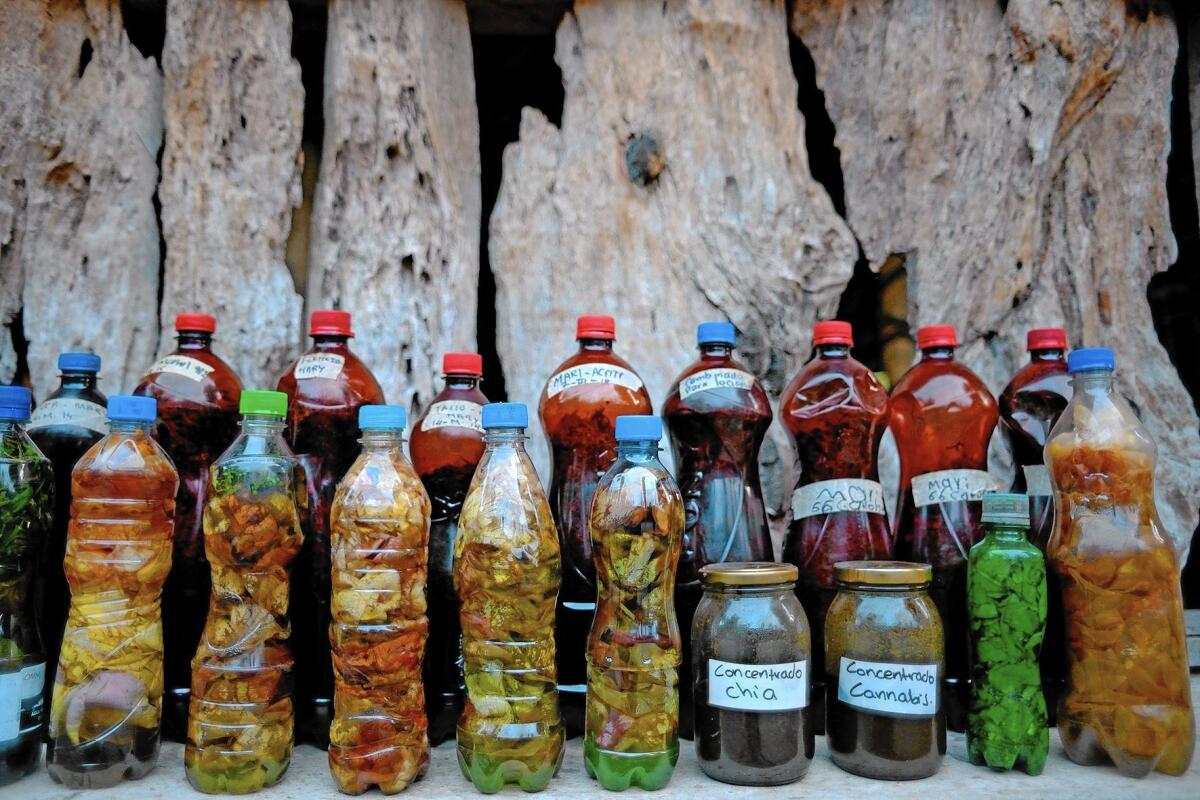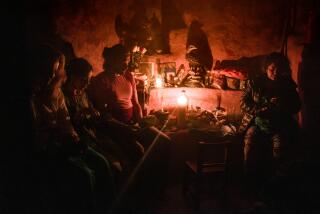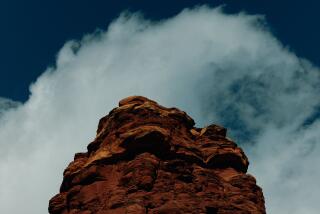Great Read: Yage tourism: Vomiting and visions in Colombia, then peace

Juan Mutumbajoy made these medicinal plant preparations in Sibundoy, Colombia.
- Share via
Reporting from Sibundoy, Colombia — Dressed in a parrot-feathered headdress and a collar strung with the teeth of pumas, crocodiles and bears, shaman Juan Mutumbajoy sings incantations over a row of shot glasses filled with a murky infusion he has made from two Amazonian vines.
He is about to administer a concoction called yage to nine mostly young visitors huddled around a fire under his maloka, a barn-like structure in the Sibundoy Valley, a verdant high-elevation plateau in southwestern Colombia.
They have traveled from as far as Spain, the United States and Germany to take the potion, a hallucinatory drug that some compare to LSD or peyote.
Six decades after Beat writer William S. Burroughs came to the region to experience the mind-expanding powers of yage (pronounced yah-HEY), they’re the latest in a growing number of seekers who have fueled an offbeat tourism boom in this out-of-the-way corner of the country.
After chanting in a singsong cadence and spreading a pungent incense around the maloka, Mutumbajoy warns the celebrants about some side effects of the “purification” ritual.
Drinking the liquid may lead to intense nausea and diarrhea, he says. Then may come scary visions of snakes, jaguars and insects. But if they stay “concentrated and confident,” they will be fine, he assures them.
“Let go of the complications in your mind and in your body,” says Mutumbajoy, 53, who around these parts is addressed as taita, the word for shaman in his Kamentsa indigenous community. “You will know secrets you have hidden away but also things you have never heard or spoken.”
One by one, the participants approach a makeshift altar covered with the skins of leopards and snakes and drink the bittersweet potion. Several of them will spend the next several hours alternately curled up on reed mats or hammocks under the maloka roof and rushing outside to vomit.
But Pau Amat, a landscape business owner from Spain who has traveled to Colombia to take part in the ceremony, says the gain is worth the pain:
“What yage gives you is a sense of inner harmony,” says the Spaniard, who calls it an increasingly popular drug in his circle.
Made from the Amazonian vine known as ayahuasca (botanical name: Banisteriopsis caapi) in combination with chagropanga or other jungle plants, yage’s potent hallucinatory powers were described in detail by Burroughs, who visited in 1953, and poet Allen Ginsberg, who in 1960 tried yage in the Amazonian town of Pucallpa, Peru.
Some say their book “The Yage Letters,” a compilation of the two writers’ letters, diary entries and essays, has done for yage what the books of Carlos Castaneda did in the 1960s and 1970s to popularize peyote. The book’s popularity has grown along with interest in the Beat writers and their freewheeling quest to, in Ginsberg’s words, “widen the area of consciousness.”
Burroughs described taking yage as a “time travel” experience also capable of producing grotesque visions.
“In two minutes, a wave of dizziness swept over me and the hut began spinning. It was like going under ether or when you are very drunk and lie down and the bed spins,” Burroughs wrote. “The hut took on an archaic far-Pacific look with Easter Island heads carved in the support posts…. Larval beings passed before my eyes in a blue haze.”
Stephen Dickey, a senior lecturer in English at UCLA, says yage was an avenue of experimentation and freedom for Burroughs, who already had become addicted to heroin.
“His use of yage was probably one more expression of his desire to escape controls, if only temporarily, and to loosen [19th century poet William] Blake’s ‘mind-forg’d manacles’ … an end in itself for Burroughs,” Dickey says.
But Mutumbajoy insists that yage is not meant to be some mental magic carpet ride but rather a sacred cure, be it for depression, kidney stones, high blood pressure or satanic possession. He says he regularly turns away people who come looking to take yage — he charges $25 per cure — strictly for recreational use.
“To be treated by me, you must want to be cured,” Mutumbajoy says.
Taking yage is not without risks. In April 2014, a 19-year-old British tourist died after taking yage in Mocoa, a town that is a 50-mile drive east of Sibundoy. Burroughs noted in a 1953 letter to Ginsberg that someone had died of an apparent yage overdose shortly before his arrival.
J. Richard Stepp, an ethnobotanist and anthropology professor at the University of Florida, acknowledges that yage is a powerful drug but says it poses no risk if administered properly.
“There is no real toxicity with the plants themselves … but a preexisting condition could play a role, or someone adds things to the mixture that shouldn’t be there,” Stepp says.
Mutumbajoy says that deaths happen only when yage is administered improperly or by “charlatans” trying to get in on a growth industry.
Locals say that increasing numbers of people, inspired by tales of miraculous cures and self-enlightenment, want to take the liquid and are willing to travel great distances to do so.
About 2,000 tourists came to Sibundoy last year — twice the number in 2010 — to take yage from one of a dozen taitas in the Kamentsa community, says Henry Mavisoy, who is chief of the Kamentsa indigenous council representing 7,500 residents.
He notes the many websites advertising yage or ayahuasca tourism, one of which touts “transcendence and transformation,” and attributes the growing popularity to the fact that indigenous shamans now routinely travel to the U.S. and Europe.
“The barriers have fallen. The figure of the taita has begun to travel around the world, and so yage began to be known as something that can be of benefit to all humanity,” Mavisoy says.
A Kamentsa shaman named Juan Bautista was arrested at Houston international airport in 2010 and spent 27 days in jail for possession of DMT, yage’s psychoactive element, which under U.S. law is considered a narcotic. The charges were later dropped.
Yage’s illegal status was challenged successfully in the U.S. Supreme Court in 2005 by a church with roots in Brazil whose ceremonies center on the vine. The court’s decision in effect gave the church an exemption from the law prohibiting DMT.
Yage is produced and administered not only in Colombia but also by many other indigenous groups in the western Amazon basin from Colombia south to Bolivia, Stepp says, speaking by phone from Florida.
“The vast majority of people involved in preparing it believe it has healing powers and religious significance,” Stepp says. Yage helps shamans in their role of “mediating between the supernatural and natural worlds,” he says.
Amat, the Spanish tourist, says he first tried in yage in Barcelona, where it was administered by a visiting shaman from Colombia, and he has taken it 11 times since.
“Nature takes on a life of its own and you feel full of light, more at equilibrium,” Amat says, describing the experience.
Mutumbajoy’s clientele, which he says averages 25 “patients” a month, includes many return customers, mainly from the region. One is 36-year-old computer programmer Alma Puenayan from the nearby city of Pasto. She says she takes yage to treat the depression she continues to suffer over her brother’s slaying in a 2008 robbery.
“It’s given me a reason to live, because through yage I found the answer to the pain I was feeling,” Puenayan says.
Like all taitas in the Kamentsa community, Mutumbajoy was anointed a shaman while still an infant by his taita grandfather, just as his grandson Jorge already has been so designated as “one who will follow.”
“It’s born to you,” Mutumbajoy says. “My father was a woodcutter who knew every plant in the forest. He introduced me to all the taitas here, and they taught me and gave me remedies at an early age. That’s part of the training, to take all of them so that we know the plants well.”
Jorge, 13, is already helping him to prepare the cures.
“Yage deserves a lot of respect,” Mutumbajoy says. “You don’t take it just for the sake of taking it.”
Kraul is a special correspondent.
More to Read
Sign up for Essential California
The most important California stories and recommendations in your inbox every morning.
You may occasionally receive promotional content from the Los Angeles Times.









